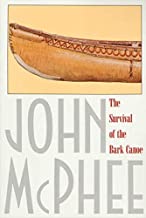The Survival of the Bark Canoe by John McPhee 1975
McPhee once again pushes off in a canoe with a fascinating person in a remote place and gets the story down on paper in his unique style—the result is a terrific book which has lost none of its impact nearly 50 years after publication.
In this case, the fascinating person is Henri Vaillancourt, a 25 year old high school graduate living in Greenville, NH, who became obsessed at the age of 15 with the bark canoes which Native Americans had been making for centuries. He discovered a book entitled ‘The Bark Canoes and Skin Boats of North America’, published in 1964 through the efforts of a Smithsonian curator who collected the work of Edwin Tappan Adney, a journalist who was fascinated with Native Americans and who studied the methodology that Canadian tribes had used in making bark canoes. Henri then devoted his life to making authentic bark canoes using only an axe, an awl, and his favorite tool, the crooked knife and only materials he found in the forests of NH and Maine. The first paragraph in the book begins: “When Henri Vaillancourt goes off to the Maine woods, he does not make extensive plans. Plans annoy him. He just gets out his pack baskets, tosses in some food and gear, takes a canoe and goes.”
The first section of the book describes Vaillancourt’s life and techniques in detail. The second describes one of those Maine trips that Vaillancourt, two brothers from Greenville, a teacher of environmental studies, and McPhee made to the Allagash Wilderness in far northwestern Maine. Paddling for hours often against white capped waves driven by high winds, portaging across mud and insect infested land, and battling no-see-ums and mosquitos, the trip is a pilgrimage to the wilderness and a living experience of Henri’s bark canoes. McPhee often quotes Thoreau who visited the same area in 1857 and wrote The Maine Woods about his experiences with his Native American guides and their bark canoes. McPhee writes: “Lake, portage, stream, we covered only ten miles today—in twelve hours of travel. I will confess that, on the whole I don’t mind these long days. I like the purpose in the motion, the clear possession of a course to follow, the sense of journey. I like to go to sleep early and wake up with the sun. In these respects, I guess, I am much like Henri,,,,Their canoe was alive in the forest only months ago, and now on the lake it is a miracle of beauty, of form and symmetry, of dark interstitial seams in mottled abstractions of bark. The time is the present, of course—effectively, and importantly, now—yet without changing a grain of the picture this could be the century before, or the century before that, or the century when the whites first came his in Indians’ bark canoes. Two straight wakes trace the way in silence toward the southern end of the lake.”
This is one of McPhee’s best and a great read for anyone who fantasizes about exploring America’s wilderness. Fifty years later, Henri Vaillancourt is still making bark canoes in Greenville, NH and the Allagash remains distant and empty in Maine.



